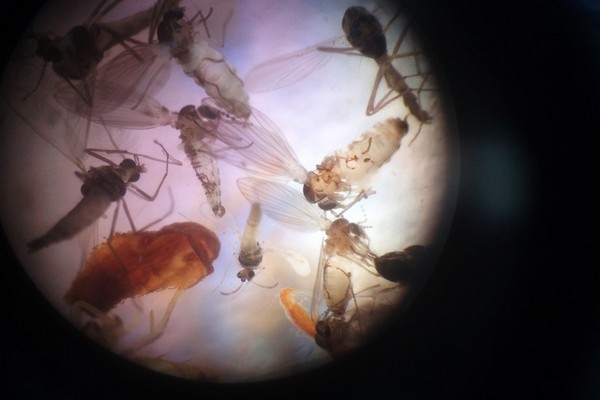How many researchers does it take to change a light bulb? And how many lives could they save by changing it?
The answer to both questions is larger than you might expect. In the developing world, light bulbs might as well be insect magnets. The light they emit — particularly the blue wavelengths of LED lights — is attractive to a range of insects, drawing them out from the night and straight to people’s homes.
Many insect species are attracted to light, which means that the type of bulb you use can actually increase the risk of catching vector-borne diseases. Six million people worldwide, mostly in Latin America, are infected with Chagas disease, which is transmitted by a bug that is attracted to lights. Sand flies, also attracted to light, infect people with a protozoan parasite responsible for 20,000 deaths annually. And mosquitos, which carry malaria, are documented to be attracted to light.
 |
|
Insects collected in a pan trap during a USC experiment on LED light bulbs (Photo Credit: Travis Longcore) |
On the same wavelength?
A new study led by a USC environmental science professor and published in Philosophical Transactions of the Royal Society B has found that what matters most isn’t just how bright your bulb is, but what color wavelengths it gives off.
Future LED bulb designs could be customized to be less attractive to specific insect species, said Travis Longcore, associate professor of spatial sciences at the USC Dornsife College of Letters, Arts and Sciences.
The white light given off by bulbs is attractive to all insects, but “white” isn’t actually a color — it’s a combination of light of all colors.
Different insects are sensitive to particular combinations of these wavelengths. Blue, violet and ultraviolet wavelengths are especially attractive to moths and many other insect groups; additionally, they’re also disruptive to human circadian rhythms, meaning they can actually interfere with sleep patterns.
With this in mind, Longcore and a team of his former students from UCLA tested to see if they could mitigate these effects as part of a research project with Philips Research in the Netherlands. Their primary goal was reducing the number of insects an LED bulb can attract while still maintaining white light for indoor use. Collaborator André Barroso, a senior scientist at Philips, provided the bulbs.
 |
|
Insects in the order Diptera include mosquitos, responsible around the world for transmitting malaria and other diseases. (Photo Credit: Travis Longcore) |
This is where lighting meets health and well-being.
André Barroso
“For the purpose of this study, we created unique and one-off LED lamp designs that can be customized to emit different color wavelengths to reduce the attraction of insects,” Barroso said. “This is where lighting meets health and well-being.
”
Study parameters
The special bulbs were tested against off-the-shelf commercial LED bulbs, compact florescent bulbs and a control with no bulb.
Longcore and his team fixed each bulb over soapy pan traps in several Los Angeles County sites: two locations in the Santa Monica Mountains represented rural conditions, while UCLA’s Mildred E. Mathias Botanical Garden stood in as an urba













